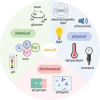Biomimetic Hydrogels - Tools for Regenerative Medicine, Oncology, and Understanding Medical Gas Plasma Therapy
- PMID: 39905967
- PMCID: PMC11878268
- DOI: 10.1002/smll.202403856
Biomimetic Hydrogels - Tools for Regenerative Medicine, Oncology, and Understanding Medical Gas Plasma Therapy
Abstract
Biomimetic hydrogels enable biochemical, cell biology, and tissue-like studies in the third dimension. Smart hydrogels are also frequently used in tissue engineering and as drug carriers for intra- or extracutaneous regenerative medicine. They have also been studied in bio-sensor development, 3D cell culture, and organoid growth optimization. Yet, many hydrogel types, adjuvant components, and cross-linking methods have emerged over decades, diversifying and complexifying such studies. Here, an evaluative overview is provided, mapping potential applications to the corresponding hydrogel tuning. Strikingly, hydrogels are ideal for studying locoregional therapy modalities, such as cold medical gas plasma technology. These partially ionized gases produce various reactive oxygen species (ROS) types along with other physico-chemical components such as ions and electric fields, and the spatio-temporal effects of these components delivered to diseased tissues remain largely elusive to date. Hence, this work outlines the promising applications of hydrogels in biomedical research in general and cold plasma science in particular and underlines the great potential of these smart scaffolds for current and future research and therapy.
Keywords: CAP; LTP; NTP; non‐thermal plasma; plasma medicine; reactive oxygen species.
© 2025 The Author(s). Small published by Wiley‐VCH GmbH.
Conflict of interest statement
The authors declare no conflict of interest.
Figures











References
-
- Okay O., in Hydrogel Sensors and Actuators, (Eds: Gerlach G., Arndt K. F.), Springer, Berlin, Heidelberg: 2009, pp. 1–14.
-
- Yahia L., J. Biomed. Sci. 2015, 4, 13.
-
- Peppas N. A., Hilt J. Z., Khademhosseini A., Langer R., Adv. Mater. 2006, 18, 1345.
-
- Xu J., Liu X., Ren X., Gao G., Eur. Polym. J. 2018, 100, 86.
Publication types
MeSH terms
Substances
Grants and funding
LinkOut - more resources
Full Text Sources
Miscellaneous

